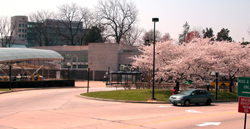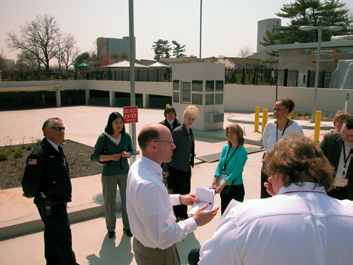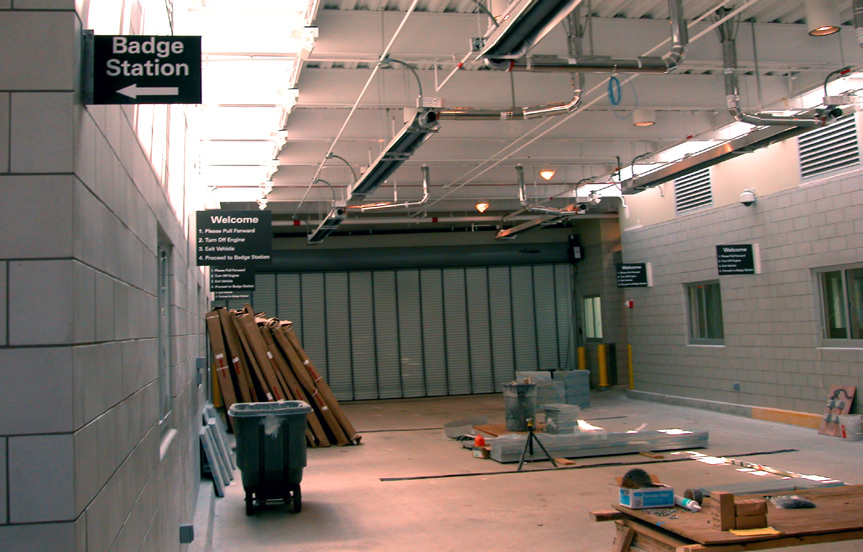| |
 |
|
|
|
|
| |
Cherry blossoms in full bloom adorn front of the new NIH Gateway Center, which is scheduled to open in July. |
|
Employees arriving on foot out of the Metro station will proceed straight ahead into the pedestrian entry. Because they will already have ID badges, they can simply walk to the five turnstiles allowing access to campus.
There will also be a “sally port” or extra-wide doors, for people using wheelchairs, bikes or strollers.
Visitors will enter the pedestrian processing facility
and pause at the counter, where five stations will issue ID badges, much like bank teller windows
or motor vehicle registration counters.
Amenities include an information desk, a large-screen TV that will list the day’s major meetings, a special VIP badging area and restrooms.
|
Above:
An artist’s rendering of what the finished Gateway Center will look like
Below: Brad Moss, communication
officer for ORS, leads a tour of the new NIH Gateway Center for members of NIH’s information community. At left is Sgt. Robert Drummond, who is in charge of facility security.
Bottom: Interior of the vehicle inspection portion of the center, Bldg. 66A  |
Visitors arriving by car will take Gateway Drive off the Pike and either proceed directly to paid parking
($2 per hour, $12 per day) or, if they intend to drive onto campus, queue up in a four-lane inspection facility. Like a toll booth, the lanes are marked by red or green lights. Visitors will pull up to the appropriate bay, turn off the ignition
and leave their vehicles to complete the ID badging process. The cars will be inspected during this time.
Vehicles that are rejected will have no choice but to head back to the Pike, while those that pass inspection will proceed onto Center Drive near the National Library of Medicine. Grounds for turning people away include having a pet in the car, or alcohol, said Lou Klepitch, a security expert in the Office of Research Services. Sgt. Robert Drummond said NIH Police have seized such contraband as shotguns, rifles, drug paraphernalia and machetes from cars trying to enter campus, and that there have been some arrests. |
 |
Because the parking garage is outside the perimeter fence, cars left there need not go through inspection. The garage’s hours, tied to visiting hours at the Clinical Center, will be 7 a.m. to 9 p.m., though fee-collection staff will be on hand from 6 a.m. to 11 or 12 at night.
The NIH information community got a sneak peek at the new facility Apr. 10, when Brad Moss, communication officer for the Office of Research Services, led a tour. He and other ORS/ORF staff pointed out such features as two “green roofs” that together eliminate 55 percent of the rain runoff from the center, carbon
monoxide sensors on the wall that activate exhaust fans, so that the air remains healthy inside the vehicle inspection bays, and blast-resistant construction.
When a Gateway Center for NIH was first envisioned,
prior to 9/11, the primary intent was not so much campus security as visitor education
and hospitality, noted John Burklow, NIH associate director for communications and public
liaison. “At one time we had plans to have our Visitor Information Center within the Gateway,”
he said. “The VIC will remain within Bldg. 45, but the [Gateway Center] will have elements of welcome.”—Rich McManus 